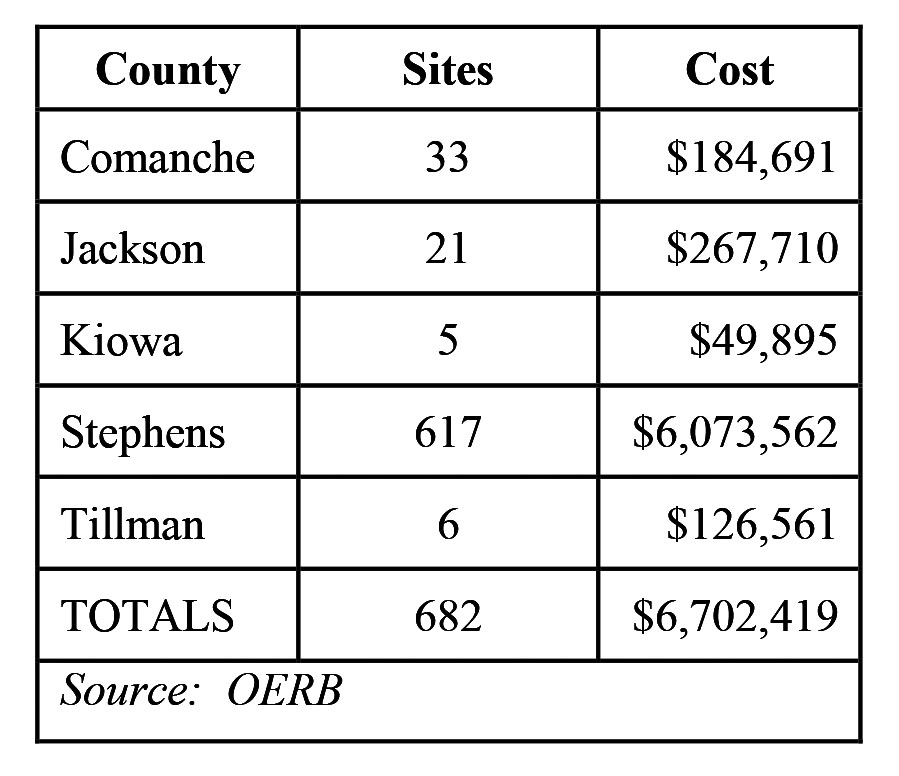OKLAHOMA CITY- Oil and gas exploration and production have been conducted in Oklahoma for 134 years, since before statehood.

Oil and gas exploration and production have been conducted in Oklahoma for 134 years, since before statehood.
The first oil well was drilled near Wapanucka in the Choctaw Nation, Indian Territory, in 1885, but the well was not completed until 1888. Only a small amount of oil and gas was produced before the site was abandoned after the financier fell ill and died.
The first commercially productive well in Indian Territory was the Nellie Johnstone No. 1 drilled in 1897 near Bartlesville, at that time in the Cherokee Nation.
Since then, tens of thousands of oil/gas wells have been drilled throughout the state.
As of late June, the Oklahoma Corporation Commission, which regulates the energy industry, counted more than 141,700 active wells in all but two of the state's 77 counties. Those included 7,983 in Stephens County and 1,580 in Comanche County, 328 in Kiowa County, 243 in Tillman County, and 113 in Jackson County.
Literally thousands of the wells drilled in Oklahoma were simply abandoned after production ceased, leaving behind open wells, unsightly structures and polluted acreage.
But today, the energy industry is spending millions to clean up problems that others created.
For example, a quarter of a century ago, in 1993, representatives of Oklahoma's oil producers and royalty owners, working with the state Legislature, established the Oklahoma Energy Resources Board (OERB); natural-gas producers joined the organization soon after.
"At the heart of our mission is the OERB's ongoing commitment" to clean up Oklahoma's abandoned well sites "left to ruin by those who have long since passed or disappeared," the privatized state agency declares.
Funded through voluntary contributions paid by producers and royalty owners, the OERB's environmental restorations "cost landowners and taxpayers nothing."
During its existence the OERB has spent $120 million to restore more than 17,000 abandoned well sites, "employing Oklahoma contractors along the way," the agency reports.
Last year the OERB spent $8 million for oil patch environmental recovery projects throughout the state, and $9 million is budgeted for Fiscal Year 2020 (July 1, 2019, through June 30, 2020).
"We restore about 750 sites a year," said Steve Sowers, the agency's environmental director. That’s equivalent to two sites per day, seven days a week, year-round. "We're working on 400 to 600 sites at any given time," he said. Each of those locations is a health and safety hazard, he noted.
Beacon Environmental, of Edmond, serves as a consultant on the restoration projects. Duties Beacon employees perform for the OERB include:
● reviewing historical aerial photographs and well record information to locate potential abandoned well sites;
● meeting with landowners on-site to assess issues associated with their property;
● developing a scope of work and a cost estimate for a project (several projects may be bid together geographically to get a better bid);
● meeting with the dirt contractor prior to commencement of construction, to re-evaluate the scope of work and to ensure that utility locators, etc., have been contacted;
● confirming when the scope of work has been accomplished;
● performing any post-sampling, monitoring, etc., that may be required, and preparing a final report.
"We address sites where no responsible party can be located" because the well operator died or declared bankruptcy, Sowers explained.
Restoration project costs range from "a few thousand dollars up to six figures," he said. For example, the OERB recently spent $76,000 to reclaim two sites on land owned by a Duncan resident. On average, the OERB spends approximately $7,000 per site, and most sites can be remediated in three to five days, Sowers said.
The OERB has spent $6.7 million to restore 682 sites in Comanche, Jackson, Stephens, Tillman and Kiowa counties, ledgers reflect.
The OERB removes concrete structures, trash and debris at old well sites, while the state Corporation Commission is responsible for plugging abandoned oil and gas wells.
The Commission has plugged 609 abandoned oil/gas wells in the last five fiscal years, records show. Fees paid by well operators were used in almost every case, but three wells were plugged in FY 2019, and 14 were plugged in FY 2018, with bond forfeiture funds, agency spokesman Matt Skinner said.
Of those 609 plugged wells, 15 were deemed to have been life-threatening or posing an immediate danger to the environment or to personal property; 69 were considered an emergency because of pollution, purging, and such; and at least 135 were potentially dangerous to personal property. The others posed no immediate danger to humans, the environment or to property.
The Corporation Commission spent a total of about $6.2 million to plug abandoned wells in FY 2014-19, Skinner said.
A landowner who has an abandoned oil or gas well site can contact the OERB about getting the location cleaned up. The OERB in turn refers the request to the Corporation Commission (or to the Bureau of Indian Affairs if the site is in Osage County) to determine whether a responsible party can be located. If not, the request then "comes back to us," Sowers said, and gets added to the list.
The OERB solicits competitive bids on its environmental reclamation projects, Sowers said.
The OERB is self-sustaining, financed from a voluntary assessment of one-tenth of 1 percent on the sale of oil and natural gas produced in Oklahoma; the fee is remitted to the Oklahoma Tax Commission in the same manner as payment of the gross production tax.
Any producer or royalty owner who does not wish to participate in the program can apply for a refund each year. Historically, 95 percent of all OERB contributions remain in the fund, making it "one of the most strongly supported check-off programs in the country," the agency contends.
OERB restoration projects are "giving energy producers a good name and contributing to their reputation," Sowers said.


